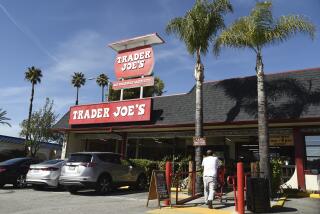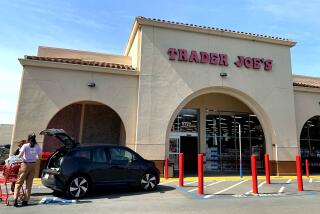Haggen chain to buy 146 Vons, Pavilions, Albertsons, Safeway stores

A supermarket David is gulping down a Goliath.
Next spring, Southern California shoppers will see a new name replacing some of their old grocery standbys: Haggen Inc.
The tiny Pacific Northwest chain is buying 146 Vons, Pavilions, Albertsons and Safeway stores, including 83 in California. The Federal Trade Commission ordered them sold as part of the merger of Albertsons and Safeway earlier this year.
That translates into an eye-popping 811% expansion for the Bellingham, Wash., company, which currently operates 18 stores in Oregon and Washington.
“This was a once-in-a-lifetime opportunity,” said Bill Shaner, the newly appointed chief executive of Haggen in the Pacific Southwest. “They are great stores in a very dynamic marketplace. The chance to grow the brand was very unique.”
The chain did not disclose financial details. Some analysts pegged the deal at $1.4 billion to $2 billion.
Landing in the highly competitive Southland grocery market will be a challenge for Haggen, especially as traditional grocers are squeezed by local favorites like Trader Joe’s and deeper competition from the likes of Wal-Mart Stores Inc. and Target Corp., which have both expanded their grocery offerings, analysts said.
“It’s certainly no slam-dunk,” said Jim Prevor, a food analyst and founder of PerishablePundit.com. “The core business of operating a conventional supermarket is really a threatened being.”
Shaner said Haggen has distinguished itself with a heavy emphasis on fresh produce and quality meats and seafood. That focus will be reflected in the new stores once they are re-branded as Haggen starting in 2015, he said.
“Haggen is between an Albertsons and Vons and what you might see to some extent in a Whole Foods,” Shaner said. “You will see a little tweak in assortment, a little tweak in the quality of the offerings.”
The company will also keep existing store employees and managers, Shaner said, expanding its worker base fivefold to 10,000.
Observers said that expanding the company to 164 stores in five states will give Haggen the muscle to negotiate more effectively with suppliers and make a real push into new territories.
“You really need a minimum of 100 stores … to have the buying power and market share to have a meaningful impact in the marketplace both with competitors and consumers,” said Burt Flickinger III, managing director of Strategic Resource Group.
But Haggen will face the challenge of introducing its unknown brand in places such as Los Angeles, where shoppers have different preferences and a multitude of supermarkets to choose from. Competition is fiercer than ever before, with newer rivals such as dollar stores increasing their produce aisles and online retailers such as Amazon.com testing grocery delivery.
“Haggen means something locally, but it’s a name unknown for most of these new areas,” Prevor said. “That means very substantial expenditures to build a brand in those areas.”
At the same time, the chain must now deal with operating a vastly bigger organization. There is a danger it will run into trouble exporting its culture to the larger group of stores and will lose some of the uniqueness that has made it successful, analysts said.
“It’s a brilliant or bankrupt strategy,” Prevor said. “When you are talking about basically increasing the business from one tiny geography to a massive scope down the West Coast, you run the real risk that they will fail.”
But Flickinger said the chance to expand so rapidly with one swoop probably was too tempting to pass up.
“It is arguably the best opportunity to expand cost effectively and in the West Coast for the last 15 years,” he said.
In March, Albertsons said it was buying rival Safeway for more than $9 billion in cash and stock. The Federal Trade Commission, which sometimes orders companies to sell off parts to avoid monopolizing a market after a merger, told the two supermarket heavyweights to unload 168 stores.
Aside from Haggen, other buyers include Associated Wholesale Grocers/Minyards, which is picking up 12 locations in Texas, and Associated Food Stores, which is buying eight stores in Montana and Wyoming.
The acquisition, which still requires FTC approval, marks a high point for Haggen after more than eight decades in the grocery business.
Ben and Dorothy Haggen, along with Dorothy’s brother Doug Clark, founded the first store in 1933 during the Great Depression with $1,100. Originally named the Economy Food Store, it was located in downtown Bellingham. The store moved to a bigger space a few years later and was renamed White House Market.
The chain did not weather the Great Recession as gracefully.
Haggen suffered as consumers tightened their belts and shopped with a sharp eye on their budgets, analysts said. Then in 2011, Florida investment firm Comvest Partners bought a majority stake from the Haggen family. The company closed some underperforming locations and has spent the last few years remodeling its stores.
Now Haggen is gearing up to take its first step in the Southland and beyond.
“The Southern California market is hyper-competitive,” Shaner said. But “we think the marriage of Haggen and Albertsons and Safeway brands can be very strong.”
Already, local growers and seafood companies in California have been reaching out to supply its stores come 2015, he said. “For fresh products there is no better place in the world.”
Twitter: @ByShanLi







